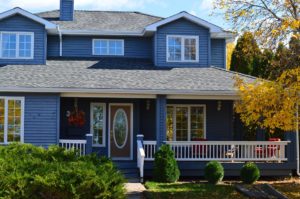Signs Your Siding Needs Replacement

You may have been outside doing a bit of spring cleaning or simply enjoying your outdoor space when you noticed that your home’s siding doesn’t look quite right. Siding offers your home durable exterior protection and excellent curb appeal but isn’t designed to last forever.
Siding needs to be in good condition to properly insulate your home, repel water, and boost energy efficiency. Here are signs to watch out for that could suggest it’s time for your siding to be replaced.
Fading and Peeling
Siding offers your home excellent curb appeal unless it has become discolored or is peeling. Discoloration and peeling are prime signs that it may need to be replaced. Nearly all types of siding, including wood, vinyl, and composite, are susceptible to fading and peeling. Usually, this is a result of daily UV exposure. If you’re considering replacing your home’s siding, you might want to check out more durable, modern siding options such as steel siding or high-quality vinyl siding that is sun-resistant and will look beautiful for years.
Loose, Cracked, or Missing
If your siding shows apparent signs of damage, such as cracks or missing pieces, this is a clear indicator that it needs an update. Storms with high winds can even loosen boards or remove them altogether. The damage leaves your home exposed to both the elements and outdoor pests. If your home’s siding looks to be in rough condition, it’s a good idea to have an expert inspect it. One of our professionals will be able to tell you whether you only need to replace a board or two or if you should update your entire home.
Warping and Rotting
Certain types of siding are more prone to warping and rotting. Nevertheless, almost every material used for siding can bend or warp over time. When your siding warps, it can create gaps that decrease your home’s insulation and provide an opportunity for water to enter. Rot, both dry and wet, is another significant issue. Commonly, rotted siding will appear soft or mushy, especially in your gutters or chimney joints. Siding with dry rot easily crumbles or disintegrates. These conditions typically necessitate replacement.
Storm Damage
Falling tree limbs, hail, and even lightning strikes can leave your siding in poor shape. It’s a good idea to inspect your home after every storm. An appraisal will allow you to spot damage, such as holes or cracks, quickly. These minor issues could turn into much bigger problems for your home’s structural framework if left unaddressed.
Growth
We all love a lush, green outdoor space, just not when it’s growing on our home’s siding! Fungus, mold, mildew, or algae often signify moisture issues. Their presence could mean that your siding is letting water infiltrate the interior of your home or that moisture is getting trapped in warped or loose siding. You’ll want to clean and remove any mold or mildew and then take a closer look into the root cause of the problem.
Interior Issues
Rising heating or cooling costs, bubbling paint on the walls, and water stains might mean it’s time to inspect and possibly replace your siding. These types of interior damage can signify that your siding is no longer doing its job protecting your house.
Whether you need to replace your siding, RI Remodel is here to help!

